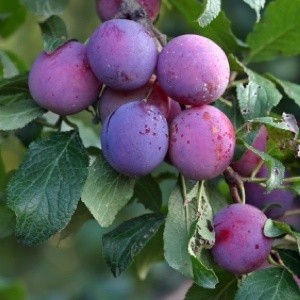
Most gardeners have only limited amounts of space, so deciding what type of fruit trees to plant warrants careful consideration. Beyond your personal preferences, you need to know which fruits grow best in your zone, how much space you will need, and what types of yields you can expect in return for your investment. If you've been considering turning part of your garden space into a mini orchard, consider planting one of more of the following hardy fruit trees.
The following fruits are considered hardy, meaning they can be grown successfully in temperate climates (climates in the middle latitudes). All require a sunny location, adequate shelter from the wind (to ensure pollination), and nutrient-rich soil deep enough to grow sturdy roots. If you live in a temperate climate and want to try growing citrus and other tropical fruits, consider growing them in containers. Many fruits such as apricots, figs, lemons, limes, or nectarines, will thrive in large tubs or pots. If your garden space is extremely limited, compact varieties of apples, plums, and cherries also grow well in containers.
Apples come in full-size, semi-dwarf, and dwarf forms. Dwarf varieties (from 3 to 10 feet tall) are easiest to grow and harvest. When buying plants, look for healthy, virus-free trees that are at least one to two years old and have a least four to five branches.
Hardiness: Apples grow well in a wide range of climates and are hardy to zones 3 through 9. Most varieties require a period of cold temperatures, so gardeners in Zones 8 and 9 should select varieties suited for milder winters. Colder zones with shorter growing seasons should plant full-sized trees (they are the hardiest) and avoid planting late season varieties.
Harvest: Late summer through autumn.
Yields: 1-3 bushels per mature tree (1 bushel = 42 to 48 lbs.).
Growing Tip: Most apple cultivars are not self-pollinating. You need to have room to plant at least two or more cultivars to ensure cross-pollination.
Peaches can be tricky to grow, but are well worth the effort. Every cultivar needs a specific "chilling" period of before its flowers will open in the spring, so gardeners need to select varieties based on the harshness of their winter and the length of their growing season. Full size peach trees get big, but they can be kept 10 to 12 feet high with regular pruning. With the exception of a few heirloom varieties, most peach trees are self-pollinating so you only need one tree to produce a crop.
Hardiness: Zones 5 through 9.
Harvest: Mid-to late summer.
Yields: 3-5 bushels per mature tree (1 bushel = 48 to 52 lbs.).
Growing Tip: In general, these fruit trees are very susceptible to insect and disease problems. Contact your county extension office to get recommendations on which cultivars grow best in your area.
Pears suffer from fewer pest and disease problems than most other fruit trees. They are closely related to apples, but easier to grow. They come in dwarf, semi-dwarf, and full-size forms. European and Asian pears are the two types most commonly grown. You need to plant two or more compatible varieties for pollination.
Hardiness: Depending on the variety, pears are hardy to Zones 3 through 9.
Harvest: Late summer through autumn.
Yields: 3-4 bushels per mature, full-size tree (1 bushel = 48 to 50 lbs.).
Growing Tip: Once picked, European pears need at least 2 or 3 weeks to ripen. Asian pears can be left on the tree to ripen without losing their flavor.
Cherries are normally referred to as either sweet or tart. They come in dwarf, semi-dwarf, or full-size forms that can grow anywhere from 6 feet to over 30 feet tall. Sweet cherries have either white or dark flesh and can be eaten in hand, straight from the tree. Like their namesake, tart cherries are sour when eaten raw, and are typically used to make jam or wine.
Hardiness: Zones 5 through 9 (sweet cherries); Zones 4 though 9 (tart cherries).
Harvest: Early summer (sweet), mid summer (tart). Eat sweet cherries right from the tree as soon as they are ripe. Tart cherries are ready when the fruit turnsvery dark in color.
Yields: 50 to 100 lbs. (sweet cherries); 30 to 50 lbs. (tart cherries).
Growing Tip: Sweet cherries can be complicated to cross-pollinate. Most need two different, yet compatible cultivars to produce fruit. All tart cherries are self-pollinating to you can plant just one. Unlike sweet cherries, they flower and produce fruit on wood from the previous year.
Plum trees are small to medium in size, and a variety exists for just about every climate. Depending on the cultivar, the fruit can be either sweet or tart, and colored purple, blue, red, yellow, or green. The three most common species are the European plum, the Japanese plum, and the wild American plum and its various hybrids.
Hardiness: American plums (Zones 4 to 8); European and plums (Zones 5 to 9); Japanese plums (Zones 6 to 10).
Harvest: Mmid to late summer.
Yields: 1 bushel per full size tree (1 bushel = 50 to 56 lbs.).
Growing Tip: No matter what variety you choose, plan space for two different cultivars. Although many are European varieties are self-fertile, they will perform much better when cross-pollinated by another European variety. The same is true for Japanese cultivars, which require either another Japanese or an American variety to produce fruit. American plums also perform best when cross-pollinated. Your nursery should be able to recommend suitable matches for each variety.

About The Author: Ellen Brown is an environmental writer and photographer and the owner of Sustainable Media, an environmental media company that specializes in helping businesses and organizations promote eco-friendly products and services.
Add your voice! Click below to comment. ThriftyFun is powered by your wisdom!
Add your voice! Click below to comment. ThriftyFun is powered by your wisdom!